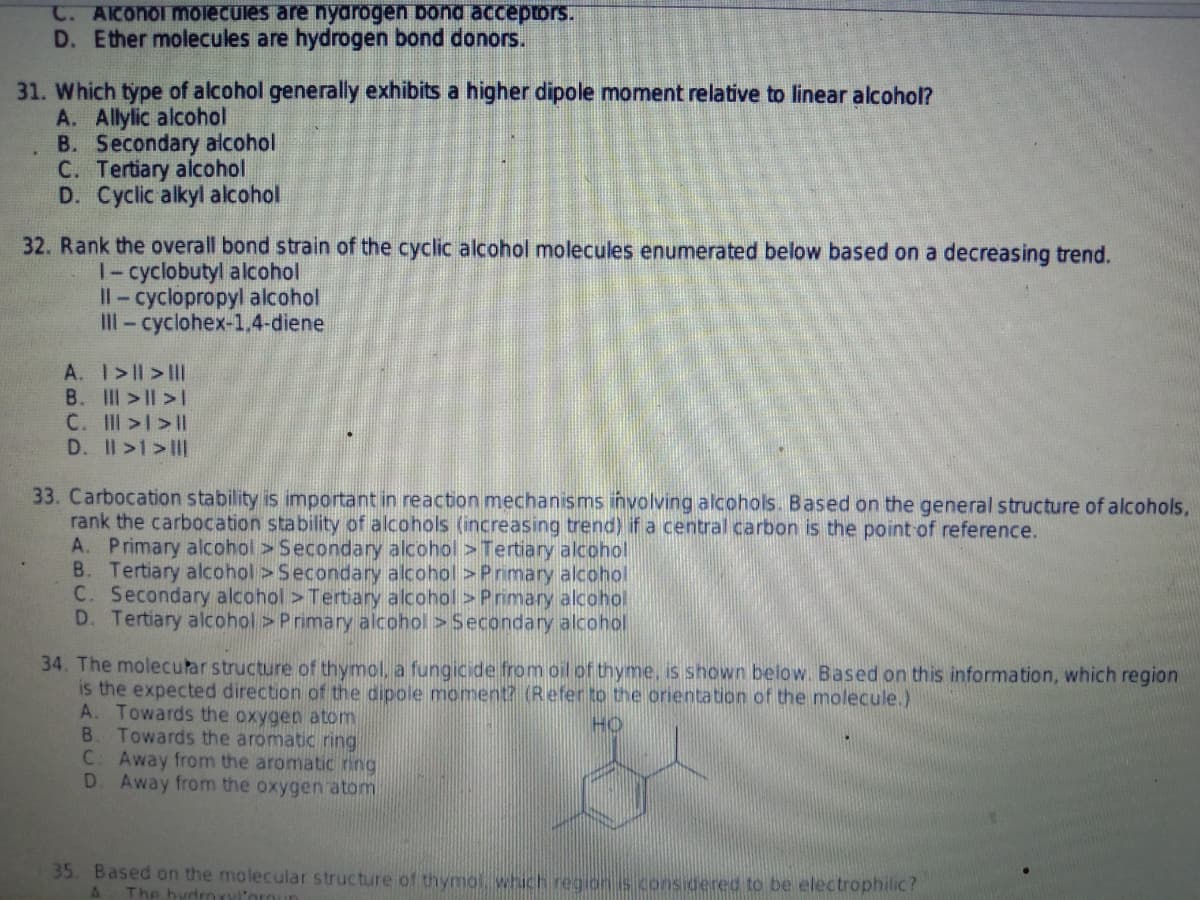C. Alcohol molecules are hydrogen bond acceptors. D. Ether molecules are hydrogen bond donors. 31. Which type of alcohol generally exhibits a higher dipole moment relative to linear alcohol? A. Allylic alcohol B. Secondary alcohol C. Tertiary alcohol D. Cyclic alkyl alcohol 32. Rank the overall bond strain of the cyclic alcohol molecules enumerated below based on a decreasing trend. 1-cyclobutyl alcohol Il-cyclopropyl alcohol III - cyclohex-1,4-diene A. I>II>I|| B. III >II>I C. III >1>11 D. II >1 >||| 33. Carbocation stability is important in reaction mechanisms involving alcohols. Based on the general structure of alcohols, rank the carbocation stability of alcohols (increasing trend) if a central carbon is the point of reference. A. Primary alcohol > Secondary alcohol > Tertiary alcohol B. Tertiary alcohol > Secondary alcohol > Primary alcohol C. Secondary alcohol > Tertiary alcohol > Primary alcohol D. Tertiary alcohol > Primary alcohol > Secondary alcohol 34. The molecular structure of thymol, a fungicide from oil of thyme, is shown below. Based on this information, which region is the expected direction of the dipole moment? (Refer to the orientation of the molecule.) A. Towards the oxygen atom HO B. Towards the aromatic ring C: Away from the aromatic ring D. Away from the oxygen atom 35. Based on the molecular structure of thymol, which reg considered to be electrophilic? A The hydroxyl'oroup
C. Alcohol molecules are hydrogen bond acceptors. D. Ether molecules are hydrogen bond donors. 31. Which type of alcohol generally exhibits a higher dipole moment relative to linear alcohol? A. Allylic alcohol B. Secondary alcohol C. Tertiary alcohol D. Cyclic alkyl alcohol 32. Rank the overall bond strain of the cyclic alcohol molecules enumerated below based on a decreasing trend. 1-cyclobutyl alcohol Il-cyclopropyl alcohol III - cyclohex-1,4-diene A. I>II>I|| B. III >II>I C. III >1>11 D. II >1 >||| 33. Carbocation stability is important in reaction mechanisms involving alcohols. Based on the general structure of alcohols, rank the carbocation stability of alcohols (increasing trend) if a central carbon is the point of reference. A. Primary alcohol > Secondary alcohol > Tertiary alcohol B. Tertiary alcohol > Secondary alcohol > Primary alcohol C. Secondary alcohol > Tertiary alcohol > Primary alcohol D. Tertiary alcohol > Primary alcohol > Secondary alcohol 34. The molecular structure of thymol, a fungicide from oil of thyme, is shown below. Based on this information, which region is the expected direction of the dipole moment? (Refer to the orientation of the molecule.) A. Towards the oxygen atom HO B. Towards the aromatic ring C: Away from the aromatic ring D. Away from the oxygen atom 35. Based on the molecular structure of thymol, which reg considered to be electrophilic? A The hydroxyl'oroup
Chapter3: Mechanisms
Section: Chapter Questions
Problem 61EQ
Related questions
Question

Transcribed Image Text:C. Alcohol molecules are hydrogen bond acceptors.
D. Ether molecules are hydrogen bond donors.
31. Which type of alcohol generally exhibits a higher dipole moment relative to linear alcohol?
A. Allylic alcohol
B. Secondary alcohol
C. Tertiary alcohol
D. Cyclic alkyl alcohol
32. Rank the overall bond strain of the cyclic alcohol molecules enumerated below based on a decreasing trend.
1-cyclobutyl alcohol
Il-cyclopropyl alcohol
Ill-cyclohex-1,4-diene
A. I>II>I||
B. III >>
C. III >1>11
D. II >1 >|||
33. Carbocation stability is important in reaction mechanisms involving alcohols. Based on the general structure of alcohols,
rank the carbocation stability of alcohols (increasing trend) if a central carbon is the point of reference.
A. Primary alcohol > Secondary alcohol > Tertiary alcohol
B. Tertiary alcohol > Secondary alcohol > Primary alcohol
C. Secondary alcohol > Tertiary alcohol > Primary alcohol
D. Tertiary alcohol > Primary alcohol > Secondary alcohol
34. The molecular structure of thymol, a fungicide from oil of thyme, is shown below. Based on this information, which region
is the expected direction of the dipole moment? (Refer to the orientation of the molecule.)
A. Towards the oxygen atom
HO
B. Towards the aromatic ring
C: Away from the aromatic ring
D. Away from the oxygen atom
35. Based on the molecular structure of thymol, which reg
considered to be electrophilic?
A The hydroxyl'oroup
Expert Solution
This question has been solved!
Explore an expertly crafted, step-by-step solution for a thorough understanding of key concepts.
Step by step
Solved in 2 steps with 2 images

Knowledge Booster
Learn more about
Need a deep-dive on the concept behind this application? Look no further. Learn more about this topic, chemistry and related others by exploring similar questions and additional content below.Recommended textbooks for you

